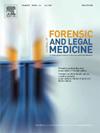Demographics and characteristics of acute sexual assault presentations to a sexual assault service within metropolitan Sydney
IF 1.2
4区 医学
Q3 MEDICINE, LEGAL
引用次数: 0
Abstract
Background
Emergency Departments (ED) are a primary avenue for the initial assessment of sexual assault presentations in Australia. The aim of this study was to outline demographics and assault characteristics of people presenting to a Sexual Assault Service (SAS).
Methods
A retrospective review of 1218 presentations to the SAS in an ED of a tertiary referral centre in metropolitan Sydney between January 2020–May 2024 was conducted using the Medical Forensic Examination Record and electronic Medical Record. Variables related to nature of the assault, injuries, the ingestion of drugs or alcohol, sexually transmitted infections, and nature of the relationship with the perpetrator were assessed.
Results
Of all presentations, 89 % of cases identified as female, with a median (interquartile range) age of 26.8 (13.7) years. Victims reported that they consumed alcohol (n = 553, 45.4 %) and/or drugs (n = 368, 30.2 %) around the time of assault in a manner where it may have impacted their level of consciousness at the time of the assault. Penile-vaginal penetration was the most common mode of assault (54.6 %), while 37.4 % of cases were found to have bodily injuries documented. Chlamydia and gonorrhoea were detected in 4.5 % and 0.8 % of presentations respectively. Of all assaults 14.6 % were perpetrated by an intimate partner.
Conclusion
Most victims of sexual assault were young females and involved penile-vaginal penetration. Intimate Partner Violence accounted for a large number of sexual assault presentations. Our findings will improve local understanding of sexual assault amongst Forensic Medical Examiner (FMEs) and Emergency physicians and inform future staffing, resourcing and research.
悉尼市区性侵犯服务中心的急性性侵犯报告的人口统计学和特征
背景:在澳大利亚,紧急部门(ED)是对性侵犯案件进行初步评估的主要途径。本研究的目的是概述到性侵犯服务(SAS)的人的人口统计和攻击特征。方法回顾性分析2020年1月至2024年5月期间悉尼市区一家三级转诊中心急诊室向SAS就诊的1218例病例,使用医学法医检查记录和电子病历。评估了与攻击性质、伤害、摄入毒品或酒精、性传播感染以及与犯罪者关系的性质有关的变量。结果在所有病例中,89%的病例为女性,年龄中位数(四分位数间距)为26.8(13.7)岁。受害者报告说,他们在袭击发生前后饮酒(n = 5553, 45.4%)和/或吸毒(n = 3668, 30.2%),这可能影响了他们在袭击发生时的意识水平。阴茎阴道插入是最常见的攻击方式(54.6%),而37.4%的案件被发现有身体伤害记录。衣原体和淋病检出率分别为4.5%和0.8%。在所有攻击中,14.6%是由亲密伴侣实施的。结论性侵受害者以年轻女性居多,涉及阴茎-阴道插入。亲密伴侣暴力在性侵犯案例中占了很大比例。我们的研究结果将提高法医和急诊医生在当地对性侵犯的理解,并为未来的人员配置、资源配置和研究提供信息。
本文章由计算机程序翻译,如有差异,请以英文原文为准。
求助全文
约1分钟内获得全文
求助全文
来源期刊

Journal of forensic and legal medicine
MEDICINE, LEGAL-
CiteScore
2.70
自引率
6.70%
发文量
106
审稿时长
57 days
期刊介绍:
The Journal of Forensic and Legal Medicine publishes topical articles on aspects of forensic and legal medicine. Specifically the Journal supports research that explores the medical principles of care and forensic assessment of individuals, whether adult or child, in contact with the judicial system. It is a fully peer-review hybrid journal with a broad international perspective.
The Journal accepts submissions of original research, review articles, and pertinent case studies, editorials, and commentaries in relevant areas of Forensic and Legal Medicine, Context of Practice, and Education and Training.
The Journal adheres to strict publication ethical guidelines, and actively supports a culture of inclusive and representative publication.
 求助内容:
求助内容: 应助结果提醒方式:
应助结果提醒方式:


